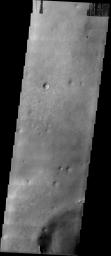
|
Destination: Meridiani
- Click the image above for a larger view
- Full-Res JPEG (1431 x 3291) (489.9 kB)
- Full-Res TIFF (1431 x 3291) (3.2 MB)
Caption:
Released 8 July 2003
Yesterday a modified Delta II rocket successfully lifted off from Cape Canaveral, Florida, sending the Mars Exploration Rover named Opportunity on its way to Mars. This THEMIS image covers part of the landing ellipse in Meridiani Planum, where the rover is expected to land in about seven months. The Meridiani Planum landing site was selected because of the detection by the Thermal Emission Spectrometer (TES) instrument on Mars Global Surveyor of a mineral called hematite, which usually forms in the presence of water. While this visible wavelength image cannot "see" hematite, what it does show is a relatively smooth (safe) area, which, in places, contains a brighter material. Because Opportunity will be able to travel dozens of meters per day, it will be able to sample both bright material and the darker material that takes up the majority of this scene. Understanding what each of these materials are and their relationship to each other will help scientists to get a better understanding of the history of water on this part of Mars.
Image information: VIS instrument. Latitude -1.8°, Longitude 354.7° East (5.3%deg; West). 19 meter/pixel resolution.
Note: this THEMIS visual image has not been radiometrically nor geometrically calibrated for this preliminary release. An empirical correction has been performed to remove instrumental effects. A linear shift has been applied in the cross-track and down-track direction to approximate spacecraft and planetary motion. Fully calibrated and geometrically projected images will be released through the Planetary Data System in accordance with Project policies at a later time.
Background Info:
NASA's Jet Propulsion Laboratory manages the 2001 Mars Odyssey mission for NASA's Office of Space Science, Washington, D.C. The Thermal Emission Imaging System (THEMIS) was developed by Arizona State University, Tempe, in collaboration with Raytheon Santa Barbara Remote Sensing. The THEMIS investigation is led by Dr. Philip Christensen at Arizona State University. Lockheed Martin Astronautics, Denver, is the prime contractor for the Odyssey project, and developed and built the orbiter. Mission operations are conducted jointly from Lockheed Martin and from JPL, a division of the California Institute of Technology in Pasadena.
Cataloging Keywords:
| Name | Value | Additional Values |
|---|---|---|
| Target | Mars | |
| System | ||
| Target Type | Planet | |
| Mission | 2001 Mars Odyssey | Mars Exploration Rover (MER), Mars Global Surveyor (MGS) |
| Instrument Host | Mars Odyssey | Mars Global Surveyor, Opportunity (MER-B) |
| Host Type | Orbiter | Rover |
| Instrument | Thermal Emission Imaging System (THEMIS) | |
| Detector | ||
| Extra Keywords | Grayscale, Thermal, Water | |
| Acquisition Date | ||
| Release Date | 2003-07-09 | |
| Date in Caption | 2003-07-08 | |
| Image Credit | NASA/JPL/Arizona State University | |
| Source | photojournal.jpl.nasa.gov/catalog/PIA04618 | |
| Identifier | PIA04618 | |
